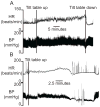Orthostatic hypotension: managing a difficult problem
- PMID: 26427904
- PMCID: PMC4883667
- DOI: 10.1586/14779072.2015.1095090
Orthostatic hypotension: managing a difficult problem
Abstract
Orthostatic hypotension (OH) leads to a significant number of hospitalizations each year, and is associated with significant morbidity and mortality among affected individuals. Given the increased risk for cardiovascular events and falls, it is important to identify the underlying etiology of OH and to choose appropriate therapeutic agents. OH can be non-neurogenic or neurogenic (arising from a central or peripheral lesion). The initial evaluation includes orthostatic vital signs, complete history and a physical examination. Patients should also be evaluated for concomitant symptoms of post-prandial hypotension and supine hypertension. Non-pharmacologic interventions are the first step for treatment of OH. The appropriate selection of medications can also help with symptomatic relief. This review highlights the pathophysiology, clinical features, diagnostic work-up and treatment of patients with neurogenic OH.
Keywords: Parkinson’s disease; autonomic failure; autonomic nervous system; droxidopa; multiple system atrophy; orthostatic hypotension; orthostatic intolerance; peripheral neuropathy.
Figures



References
-
- Rose KM, Eigenbrodt ML, Biga RL, et al. Orthostatic hypotension predicts mortality in middle-aged adults: The atherosclerosis risk in communities (ARIC) study. Circulation. 2006 Aug 15;114(7):630–6. - PubMed
-
- Angelousi A, Girerd N, Benetos A, et al. Association between orthostatic hypotension and cardiovascular risk, cerebrovascular risk, cognitive decline and falls as well as overall mortality: A systematic review and meta-analysis. J Hypertens. 2014 Aug;32(8):1562, 71. There have been a series of studies over the last few years that have noted the association between orthostatic hypotension (even asymptomatic) and increased cardiovascular risk and mortality over the next 10–20 years. This meta-analysis summarizes some of these data. - PubMed
-
- Masaki KH, Schatz IJ, Burchfiel CM, et al. Orthostatic hypotension predicts mortality in elderly men: The honolulu heart program. Circulation. 1998 Nov 24;98(21):2290–5. - PubMed
-
- Ooi WL, Hossain M, Lipsitz LA. The association between orthostatic hypotension and recurrent falls in nursing home residents. Am J Med. 2000 Feb;108(2):106–11. - PubMed
Publication types
MeSH terms
Grants and funding
LinkOut - more resources
Full Text Sources
Other Literature Sources
Medical
